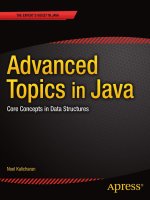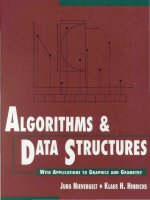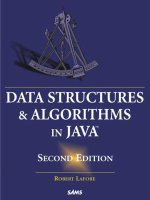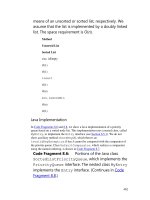Data structures with java 2nd
Bạn đang xem bản rút gọn của tài liệu. Xem và tải ngay bản đầy đủ của tài liệu tại đây (7.23 MB, 351 trang )
SCHAUM’S
OUTLINE OF
DATA
STRUCTURES
WITH JAVA
This page intentionally left blank
SCHAUM’S
OUTLINE OF
DATA
STRUCTURES
WITH JAVA
Second Edition
JOHN R. HUBBARD, Ph.D.
Professor of Mathematics and Computer Science
University of Richmond
Schaum’s Outline Series
McGRAW-HILL
New York Chicago San Francisco
Lisbon London Madrid Mexico City
Milan New Delhi San Juan
Singapore Sydney Toronto
Copyright © 2007, 2001 by The McGraw-Hill Companies, Inc. All rights reserved. Manufactured in the United States of America. Except
as permitted under the United States Copyright Act of 1976, no part of this publication may be reproduced or distributed in any form or by
any means, or stored in a database or retrieval system, without the prior written permission of the publisher.
0-07-150993-3
The material in this eBook also appears in the print version of this title: 0-07-147698-9.
All trademarks are trademarks of their respective owners. Rather than put a trademark symbol after every occurrence of a trademarked
name, we use names in an editorial fashion only, and to the benefit of the trademark owner, with no intention of infringement of the
trademark. Where such designations appear in this book, they have been printed with initial caps.
McGraw-Hill eBooks are available at special quantity discounts to use as premiums and sales promotions, or for use in corporate training
programs. For more information, please contact George Hoare, Special Sales, at or (212) 904-4069.
TERMS OF USE
This is a copyrighted work and The McGraw-Hill Companies, Inc. (“McGraw-Hill”) and its licensors reserve all rights in and to the work.
Use of this work is subject to these terms. Except as permitted under the Copyright Act of 1976 and the right to store and retrieve one copy
of the work, you may not decompile, disassemble, reverse engineer, reproduce, modify, create derivative works based upon, transmit,
distribute, disseminate, sell, publish or sublicense the work or any part of it without McGraw-Hill’s prior consent. You may use the work
for your own noncommercial and personal use; any other use of the work is strictly prohibited. Your right to use the work may be terminated if you fail to comply with these terms.
THE WORK IS PROVIDED “AS IS.” McGRAW-HILL AND ITS LICENSORS MAKE NO GUARANTEES OR WARRANTIES AS TO
THE ACCURACY, ADEQUACY OR COMPLETENESS OF OR RESULTS TO BE OBTAINED FROM USING THE WORK,
INCLUDING ANY INFORMATION THAT CAN BE ACCESSED THROUGH THE WORK VIA HYPERLINK OR OTHERWISE,
AND EXPRESSLY DISCLAIM ANY WARRANTY, EXPRESS OR IMPLIED, INCLUDING BUT NOT LIMITED TO IMPLIED
WARRANTIES OF MERCHANTABILITY OR FITNESS FOR A PARTICULAR PURPOSE. McGraw-Hill and its licensors do not warrant or guarantee that the functions contained in the work will meet your requirements or that its operation will be uninterrupted or error
free. Neither McGraw-Hill nor its licensors shall be liable to you or anyone else for any inaccuracy, error or omission, regardless of cause,
in the work or for any damages resulting therefrom. McGraw-Hill has no responsibility for the content of any information accessed through
the work. Under no circumstances shall McGraw-Hill and/or its licensors be liable for any indirect, incidental, special, punitive,
consequential or similar damages that result from the use of or inability to use the work, even if any of them has been advised of the
possibility of such damages. This limitation of liability shall apply to any claim or cause whatsoever whether such claim or cause arises in
contract, tort or otherwise.
DOI: 10.1036/0071476989
Professional
Want to learn more?
We hope you enjoy this
McGraw-Hill eBook! If
you’d like more information about this book,
its author, or related books and websites,
please click here.
To Anita
This page intentionally left blank
PREFACE
Like other Schaum’s Outlines, this book is intended to be used primarily for self study. It is
suitable as a study guide in a course on data structures using the Java programming language. In
American universities, this is typically the second course in the computer science major. The
book is also serves well as a reference on data structures and the Java Collections Framework.
The book includes more than 200 detailed examples and over 260 solved problems. The
author firmly believes that programming is learned best by practice, following a well-constructed
collection of examples with complete explanations. This book is designed to provide that
support.
This second edition is a major improvement over the original 2001 edition. Most of the
chapters have been completely rewritten. Three entirely new chapters have been added, on
object-oriented programming, linked structures, and the Java Collections Framework.
Java 6.0 is used throughout the book, with special attention to these new features of the
language:
• The Scanner class.
• The StringBuilder class.
• Formatted output, including the printf() method.
• The enhanced for loop (also called the for-each loop).
• Static imports.
• enum types.
• Variable length parameter lists.
• Autoboxing.
• Generic classes
• The Deque , ArrayDeque , EnumSet , and EnumMap classes, and the Queue interface
in the Java Collections Framework.
Source code for all the examples, solved problems, and supplementary programming
problems may be downloaded from the author’s Web site
/>
I wish to thank all my friends, colleagues, students, and the McGraw-Hill staff who have
helped me with the critical review of this manuscript, including Stephan Chipilov and Sheena
Walker. Special thanks to my colleague Anita Huray Hubbard for her advice, encouragement,
and supply of creative problems for this book.
JOHN R. HUBBARD
Richmond, Virginia
vii
This page intentionally left blank
For more information about this title, click here
CONTENTS
Chapter 1
Object-Oriented Programming
1
Software Design and Development 1
Object-Oriented Design 2
Abstract Data Types 3
Java Interfaces 4
Classes and Objects 5
Modifiers 8
Composition, Aggregation, and Inheritance 10
The Unified Modeling Language 13
Polymorphism 14
Javadoc 16
Chapter 2
Arrays
26
Properties of Arrays 26
Duplicating an Array 28
The java.util.Arrays Class 29
The Sequential Search Algorithm 30
The Binary Search Algorithm 31
Chapter 3
Linked Data Structures
46
Maintaining an Ordered Array 46
Indirect Reference 47
Linked Nodes 50
Inserting an Element into a Linked List 55
Inserting at the Front of the List 58
Deleting from a Sorted Linked List 59
Nested Classes 59
Chapter 4
The Java Collections Framework
The Inheritance Hierarchy 69
The Collection Interface 70
ix
69
x
CONTENTS
The HashSet Class 72
Generic Collections 74
Generic Methods 76
Generic Wildcards 76
Iterators 77
The TreeSet Class 79
The LinkedHashSet Class 83
The EnumSet Class 83
The List Interface 85
The ArrayList and Vector Classes 86
The LinkedList Class 86
The ListIterator Interface 87
The Queue Interface 87
The PriorityQueue Class 90
The Deque Interface and ArrayDeque Class 91
The Map Interface and Its Implementing Classes 92
The Arrays Class 95
The Collections Class 96
Autoboxing 97
Chapter 5
Stacks
103
Stack Operations 103
The JCF Stack Class 103
A Stack Interface 104
An Indexed Implementation 104
A Linked Implementation 106
Abstracting the Common Code 108
Application: An RPN Calculator 109
Chapter 6
Queues
117
Queue Operations 117
The JCF Queue Interface 117
A Simple Queue Interface 118
An Indexed Implementation 119
An Indexed Implementation 120
Application: A Client-Server System
Chapter 7
Lists
121
131
The JCF List Interface 131
The Range-View Operation sublist()
List Iterators 133
Other List Types 136
Application: The Josephus Problem 140
Application: A Polynomial Class 141
132
CONTENTS
Chapter 8
Hash Tables
148
The Java Map Interface 148
The HashMap Class 149
Java Hash Codes 150
Hash Tables 151
Hash Table Performance 153
Collision Resolution Algorithms 154
Separate Chaining 156
Applications 157
The TreeMap Class 159
Chapter 9
Recursion
165
Simple Recursive Functions 165
Basis and Recursive Parts 166
Tracing A Recursive Call 167
The Recursive Binary Search 168
Binomial Coefficients 169
The Euclidean Algorithm 171
Inductive Proof of Correctness 171
Complexity Analysis 172
Dynamic Programming 173
The Towers of Hanoi 173
Mutual Recursion 175
Chapter 10
Trees
186
Tree Definitions 186
Decision Trees 188
Transition Diagrams 189
Ordered Trees 191
Traversal Algorithms 192
Chapter 11
Binary Trees
200
Definitions 200
Counting Binary Trees 201
Full Binary Trees 202
Identity, Equality, and Isomorphism 203
Complete Binary Trees 205
Binary Tree Traversal Algorithms 207
Expression Trees 209
A BinaryTree Class 211
Implementations of The Traversal Algorithms 216
Forests 219
xi
xii
Chapter 12
CONTENTS
Search Trees
230
Multiway Search Trees 230
B-trees 232
Binary Search Trees 234
Performance of Binary Search Trees 236
AVL Trees 237
Chapter 13
Heaps and Priority Queues
Heaps 245
The Natural Mapping 245
Insertion Into A Heap 246
Removal From A Heap 247
Priority Queues 247
The JCF PriorityQueue Class
Chapter 14
Sorting
245
248
255
Code Preliminaries 255
The Java Arrays.sort() Method 256
The Bubble Sort 256
The Selection Sort 257
The Insertion Sort 258
The Shell Sort 259
The Merge Sort 260
The Quick Sort 263
The Heap Sort 265
The Speed Limit For Comparison Sorts 269
The Radix Sort 270
The Bucket Sort 271
Chapter 15
Graphs
285
Simple Graphs 285
Graph Terminology 285
Paths and Cycles 286
Isomorphic Graphs 288
The Adjacency Matrix for a Graph 290
The Incidence Matrix for a Graph 291
The Adjacency List for a Graph 291
Digraphs 292
Paths in a Digraph 294
Weighted Digraphs and Graphs 295
Euler Paths and Hamiltonian Cycles 295
Dijkstra’s Algorithm 297
Graph Traversal Algorithms 300
CONTENTS
APPENDIX
Essential Mathematics
xiii
319
The Floor and Ceiling Functions 319
Logarithms 319
Asymptotic Complexity Classes 320
The First Principle of Mathematical Induction 321
The Second Principle of Mathematical Induction 322
Geometric Series 323
Other Summation Formulas 323
Harmonic Numbers 324
Stirling’s Formula 325
Fibonacci Numbers 326
INDEX
329
This page intentionally left blank
SCHAUM’S
OUTLINE OF
DATA
STRUCTURES
WITH JAVA
This page intentionally left blank
CHAPTER 1
Object-Oriented Programming
SOFTWARE DESIGN AND DEVELOPMENT
Successful computer software is produced in a sequence of
stages that are typically managed by separate teams of developers. These stages are illustrated in Figure 1.1.
The first stage is a recognition of the problem to be solved. In
a corporate setting, this determination could come from market
research.
The second stage, which might be omitted as a formal
process, is a study of whether the project is feasible. For
example, do the development tools exist to produce the
software?
In the third stage, a document is typically produced that
specifies precisely what the software should do. This requirements document should have enough detail to be used as a
standard when the completed software is tested.
In the fourth stage, a thorough analysis is done before any
effort or resources are spent designing and implementing the
project. This could include a survey of comparable software
already available and a cost-benefit analysis of the value of
spending the anticipated resources.
Once a decision has been made to proceed, the software
design team works from the requirements document to design
the software. This includes the specification of all the software
components and their interrelationships. It may also require the
specification of specialized algorithms that would be implemented in the software.
The implementation consists of programmers coding the
Figure 1.1 Software life cycle
design to produce the software.
The testing team attempts to ensure that the resulting
software satisfies the requirements document. Failure at this point may require a redesign or even
some fine-tuning of the requirements. Those eventualities are represented by the two feedback
loops shown in Figure 1.1.
1
2
OBJECT-ORIENTED PROGRAMMING
[CHAP. 1
Testing occurs at several levels. Individual classes and methods have to be tested separately,
and then their success at working together must be verified. Finally, the product as a whole is
tested against the requirements document.
One final aspect of software development that is not shown in the figure is the maintenance
process. After the software has been delivered, its developers remain obliged to maintain it with
corrected versions, service packages, and even major revisions. Any major revision itself would
follow the same life cycle steps.
OBJECT-ORIENTED DESIGN
One common approach to software design is a top-down design strategy that gradually breaks
the problem down into smaller parts. This is also called step-wise refinement. It focuses on the
functional aspects of the problem and the implementation of algorithms. This procedure-oriented
design is common in scientific programming.
In contrast, object-oriented design focuses on the data components of the software, organizing
the design around their representatives. For example, an air traffic control system might be
designed in terms of airplanes, airports, pilots, controllers, and other “objects.”
The Java programming language is particularly well-suited for implementing object-oriented
designs. All executable code in Java is organized into classes that represent objects. For this
reason, Java is regarded as an object-oriented programming language.
An object is a software unit that is produced according to a unique class specification. It is
called an instance of its class, and the process of creating it is called instantiating the class. For
example, this code instantiates the java.util.Date class:
java.util.Date today = new
java.util.Date();
The variable today is a reference to the object, as shown in
Figure 1.2. Ignoring the distinction between a reference and
the object to which it refers, we would also say today is the
Figure 1.2 A Java object
name of the java.util.Date object.
A Java class consists of three kinds of members: fields, methods, and constructors. The fields
hold the data for class objects, the methods hold the statements that are executed by the objects,
and the constructors hold the code that initializes the objects’ fields.
An object-oriented design specifies the classes that will be
instantiated in the software. That design can be facilitated and
illustrated by the Unified Modeling Language (UML). In
UML, each class is represented by a rectangle with separate
parts for listing the class’s name, its fields, and its methods and
constructors.
Figure 1.3 shows a UML diagram for a Person class with
four fields (name, id, sex, and dob), a constructor, and three
methods (isAnAdult(), setDob(), and toString()). Each
of the eight class members is prefaced with a visibility symbol:
Figure 1.3 A UML diagram
+ means public
# for protected
- for private
(Package visibility has no UML symbol.)
CHAP. 1]
OBJECT-ORIENTED PROGRAMMING
3
UML diagrams are independent of any implementing programming language. They are used
in object-oriented design to specify objects. They should be easy to implement in Java, C++, or
any other object-oriented programming language. They provide a kind of pseudo-code for
classes. They specify the state (i.e., fields) and the behavior (i.e., methods) of an object without
specifying how that behavior is accomplished. UML diagrams include no executable code.
Specifying what an object can do without specifying how it does it is an abstraction. It allows
the design stage to be separated from the implementation stage of the software development. It
also facilitates modification of the software by allowing an implementation to be changed
without affecting dependent modules. As long as a method’s behavior is unchanged, any invoking modules will be unaffected by a change in that method’s implementation.
For example, suppose that an airline reservation system uses the Person class specified by the
UML diagram in Figure 1.3. Presumably, that software will invoke that class’s isAnAdult()
method in various modules of the system. The “contract” specified by the software design only
requires that the method return the right answer: x.isAnAdult() should be true if and only if x
is an adult. How it computes that result is irrelevant. The implementation probably computes the
chronological difference between the value of the private field x.dob and the value of the
current date. But there is nothing in the contract that specifies that. Moreover, if the implementation is changed, none of the other code in the reservation system would be affected by that
change. Such a change might be warranted by the preference of a different algorithm for computing chronological differences, or possibly by a redefinition of the meaning of “adult.”
Concealing the implementation of a method from the clients who use the method is called
information hiding. It is the software designer’s version of the spy’s principle that says, “If you
don’t need to know it, then you’re are not allowed to know it.” It makes software easier to
design, implement, and modify.
ABSTRACT DATA TYPES
Abstractions are used to help understand complex systems. Even though they are different,
rocks and tennis balls fall at the same rate. The physicist uses the abstraction of imagining a
single imaginary point mass to understand the physics of falling bodies. By ignoring the irrelevancies (diameter, weight), the abstraction allows the analyst to focus on the relevancies (height).
Abstractions are widely used in software development. UML diagrams provide abstractions
by focusing on the fields (the state) and methods (the behavior) of a class. But at some levels,
even the fields of a class may be irrelevant.
An abstract data type (ADT) is a specification of only the behavior of instances of that type.
Such a specification may be all that is needed to design a module that uses the type.
Primitive types are like ADTs. We know what the int type can do (add, subtract, multiply,
etc.). But we need not know how it does these operations. And we need not even know how an
int is actually stored. As clients, we can use the int operations without having to know how
they are implemented. In fact, if we had to think about how they are implemented, it would
probably be a distraction from designing the software that will use them. Likewise, if you had to
think about how your car manages to turn its front wheels when you turn the steering wheel, it
would probably be more difficult to drive!
4
OBJECT-ORIENTED PROGRAMMING
[CHAP. 1
EXAMPLE 1.1 An ADT for Fractions
Most programming languages have types for integers and real (decimal) numbers, but not for fractions.
Such numbers can be implemented as objects. Here is a design for a fraction type:
ADT: Fraction
plus(Fraction): Fraction
times(Integer): Fraction
times(Fraction): Fraction
reciprocal(): Fraction
value(): Real
This ADT specifies five operations. Note that the times() operation is overloaded.
Note that the ADT uses generic terms for types: Integer instead of int, and Real instead of double.
That is because it is supposed to be independent of any specific programming language.
In general, a complete ADT would also include documentation that explains exactly how each operation should behave. For example,
x.plus(y) returns the Fraction that represents x + y
x.times(n) returns the Fraction that represents n*x
x.times(y) returns the Fraction that represents x*y
x.reciprocal() returns the Fraction that represents 1/x
x.value() returns the numerical value of x
UML diagrams can be used to specify ADTs simply by
omitting the state information. The Fraction ADT defined in
Example 1.1 is shown as a UML diagram in Figure 1.4.
ADTs can be used in pseudocode to implement algorithms
independently of any specific programming language. This is
illustrated in Example 1.2.
Figure 1.4 An ADT in UML
EXAMPLE 1.2 Using an ADT in an Algorithm
The harmonic mean of two numbers x and y is the number h defined by the formula h = 2/(1/x + 1/y). In
pseudocode for Fraction types, this could be expressed as:
harmonicMean(x: Fraction, y: Fraction) returns Fraction
return x.reciprocal().plus(y.reciprocal()).reciprocal().times(2);
JAVA INTERFACES
In Java, an ADT can be represented by an interface. Recall that a Java interface is just like a
Java class, except that it contains no executable code.
EXAMPLE 1.3 A Fraction Interface
1
2
3
4
5
6
7
public interface Fraction {
Fraction plus(Fraction x);
Fraction times(int n);
Fraction times(Fraction x);
Fraction reciprocal();
double value();
}
This is a direct translation into Java of the ADT specified in Example 1.1.
If an ADT is translated into Java as an interface, then we can implement algorithms that use it
as Java methods.
CHAP. 1]
OBJECT-ORIENTED PROGRAMMING
5
EXAMPLE 1.4 A harmonicMean() Method
1
2
3
public Fraction harmonicMean(Fraction x, Fraction y) {
return x.reciprocal().plus(y.reciprocal()).reciprocal().times(2);
}
Although the Java code in Example 1.4 cannot be executed, we can compile it.
In Java, an interface is a type. Reference variables may be declared to have an interface type,
even if the interface has no implementation. For example, the parameters x and y at line 1 of
Example 1.4 are declared to have type Fraction.
An interface may represent an ADT, as in Example 1.3. More generally, a Java interface is
meant to identify a capability. For example, the Comparable interface requires the implementation of this method:
int compareTo(T type)
This means that any variable declared to have type Comparable can invoke this method,
meaning that it is capable of being compared to other objects.
CLASSES AND OBJECTS
Java is a strongly typed language: Every variable must be declared to have a data type. The
various Java types are shown in Figure 1.5. These are categorized as either primitive types or
reference types. The eight built-in primitive types are for integers, characters, decimal numbers,
and boolean values. Reference types are user-defined, and their variables must be instantiated to
hold data. Arrays are reviewed in Chapter 2; interfaces are types that cannot be instantiated;
enum types are defined by listing all the values that a variable of that type may have.
Classes are concrete data types that specify how their state is stored (the class fields) and how
their instances behave (the instance methods). A class is defined in a declaration statement with
this syntax:
modifers class class-name associations {
declarations
}
where modifers are keywords such as public and abstract, class-name is an identifier such
as Person that names the class, associations are clauses such as extends Object, and
declarations are declarations of the class’s members.
A class can have six kinds of members:
1. Fields that specify the kind of data that the objects hold.
2. Constructors that specify how the objects are to be created.
3. Methods that specify the operations that the objects can perform.
4. Nested classes.
5. Interfaces.
6. Enum type definitions.
Each member of a class must be specified in its own declaration statement. The purpose of a
declaration is to introduce an identifier to the compiler. It provides all the information that the
compiler needs in order to compile statements that use that identifier.
A field is a variable that holds data for the object. The simplest kind of field declaration has
this syntax:
modifers type name = initializer;
6
OBJECT-ORIENTED PROGRAMMING
where modifers and the initializer are
optional. For example, the Point class in
Example 1.5 declares two fields at lines 2–3.
Each has the modifier protected, which means
that they are accessible only from within the
class itself and from its extensions.
A constructor is a subprogram that creates an
object. It’s like a method with these distinctions:
• Its name is the same as its class
name.
• It has no return type.
• It is invoked by the new operator.
The simplest kind of constructor declaration
has this syntax:
modifers name(param-decls) {
statements
}
Note that a class need not have a main()
method. If it does, it is then an executable
program. Otherwise, it merely defines a new
type that can be used elsewhere.
Java data types
Primitive types
Numeric types
Integer types
Integers
byte
short
int
long
Characters
byte
Floating point types
float
double
Boolean type
boolean
Reference types
Arrays
Interfaces
Classes
Enums
EXAMPLE 1.5 A Ratio Class
1
2
3
4
public class Ratio {
protected int num;
protected int den;
public static final Ratio ZERO = new Ratio();
5
6
7
8
private Ratio() {
this(0, 1);
}
9
10
11
12
13
public Ratio(int num, int den) {
this.num = num;
this.den = den;
}
14
15
16
17
18
19
20
21
22
23
public boolean equals(Object object) {
if (object==this) {
return true;
} else if (!(object instanceof Ratio)) {
return false;
}
Ratio that = (Ratio)object;
return (this.num*that.den == that.num*this.den);
}
24
25
26
27
28
public int getNum() {
return num;
}
[CHAP. 1
Figure 1.5 Java types
CHAP. 1]
OBJECT-ORIENTED PROGRAMMING
7
public int getDen() {
return den;
}
29
30
31
32
public String toString() {
return String.format("%d/%d", num, den);
}
33
34
35
36
public double value() {
return (double)num/den;
}
37
38
39
40
}
Instances of this class represent fractions, with numerator (num) and denominator (den). The static
final field ZERO represents the fraction 0/1. It is defined to be static because it is unique to the class
itself — there shouldn’t be more than one ZERO object.
In addition to its three fields, this class has two constructors and four methods. The no-arg constructor
(it has no arguments) defined at line 6 is declared private so that it cannot be invoked from outside of its
class. It is invoked at line 4 to initialize the ZERO object. This constructor uses the this keyword at line 7 to
invoke the two-arg constructor, passing 0 to num and 1 to den.
The two-arg constructor at line 10 is provided to the public for constructing Ratio objects with specific
num and den values. Note that, to prevent the ZERO object from being duplicated, we could have included
this at line11:
if (num == 0) {
throw new IllegalArgumentException("Use Ratio.ZERO");
}
But then we would have to replace line 7 with explicit initializations:
num = 0;
den = 1;
instead of invoking the two-arg constructor there.
The equals() method at line 15 overrides the default equals() method that is defined in the Object
class (which all other classes extend). Its purpose is to return true if and only if its explicit argument
(object) represents the same thing as its implicit argument (this). It returns true immediately (at line
17) if the two objects are merely different names for the same object. On the other hand, it returns false
(at line 19) if the explicit argument is not even the right type. These tests for the two extremes are canonical and should be done first in every equals() method. If they both are passed, then we can recast the
explicit argument as an object of the same type as the implicit argument (Ratio) so we can access its
fields (num and den). The test for equality of two ratios a/b = c/d is whether a*d = b*c, which is done at
line 22.
The methods defined at lines 25 and 29 are accessor methods (also called “getter methods”) providing
public access to the class’s private fields.
The toString() method at line 33 also overrides the corresponding method that is defined in the
Object class. Its purpose is to return a String representation of its implicit argument. It is invoked
automatically whenever a reference to an instance of the class appears in an expression where a String
object is expected. For example, at line 6 in the test program below, the expression "x = " + x concatenates the string "x = " with the reference x. That reference is replaced by the string "22/7" that is
returned by an implicit invocation of the toString() method.
Finally, the value() method at line 37 returns a decimal approximation of the numerical value of the
ratio. For example, at line 7 in the test program below, x.value() returns the double value
3.142857142857143.









